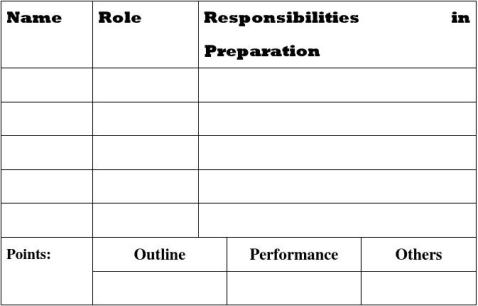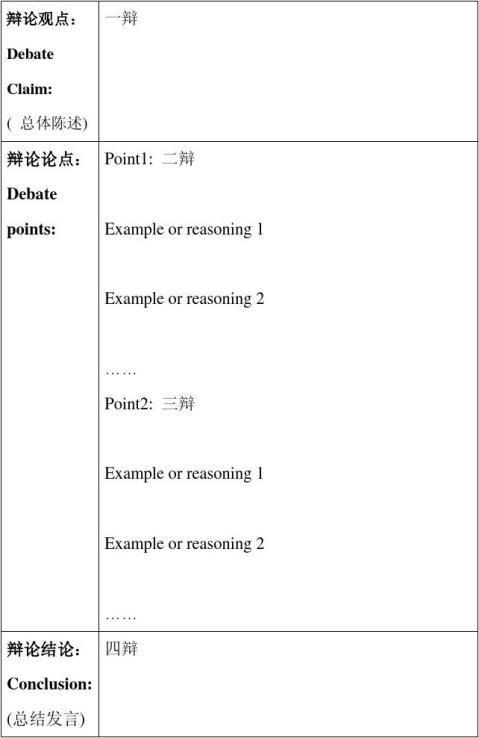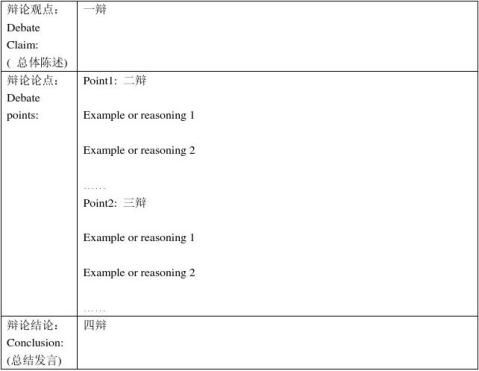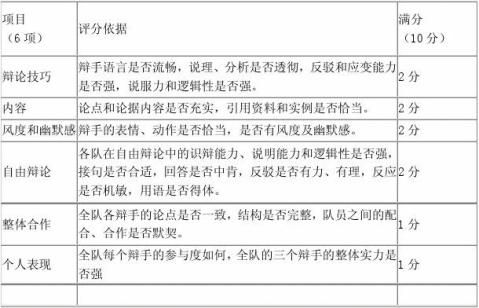Term Project 2 June 2011
Debate
_________________________________________ topic:
_______________________________________________________
By Group ______


Debate Procedure
时间:本学期第十五周,同时提交本文档前两页。
A. 组队及分工:
1. 每个小组组成辩论团队。团队成员分成一辩、二辩、三辩、四辩或五辩。 一辩(debater 1):主题发言。总体陈述本队观点和论据。(一分钟) 二辩(debater 2):针对本队的1、2论据进行具体说明和阐述。(30秒) 三辩(debater 3):针对本队的3、4论据进行具体说明和阐述。(30秒) 四/五辩(debater 4 / 5):总结发言。重新总结归纳强调本队观点并适当归纳反

B. 辩论程序:
1. 主席开场,介绍对垒队伍、评判小组、比赛规则,宣布比赛开始。
2. 正方一辩首先发言,接着由反方一辩发言,每人发言时间各为1分钟。
3. 正方二辩发言,接着由反方二辩发言;正方三辩发言,接着由反方三辩发言;每人发言时间各为30秒。
4. 自由辩论两队共计8-10分钟(参看自由辩论规则)。
5. 反方四辩/五辨总结陈词, 正方四辩/五辨总结陈词。正反方各有1分钟。
(如果参赛人数为三人,则由三辨总结陈词,如果参赛人数为四人,则由 四辨总结陈词,依此类推)。
6. 各位辩手应严格掌控时间。主席示意后辩手必须立刻停止发言。
7. 由评判小组成员打分。
C.自由辩论规则:
1. 在自由辩论时间里,每一位辩手的发言次序、次数不限,但每次的发言时间不得超过1分钟。
2. 自由辩论时间开始时,正方的任何一位队员先起立发言。在其结束发言后,反方的任何一位队员应立即发言,双方依此程序轮流发言,直到自由辩论时间用完为止。
3.如一方发言完毕,对方不能及时衔接发言,本方其他成员可继续发言。不能衔接方将被酌情扣分。
4.自由辩论过程中,如本方某成员始终未发言,则在本方总得分中扣除0.5分。依此类推。
D. 评价标准及评判

2. 评判小组由各小组派出一名成员组成按规则打分。评判员不得给自己小组打分。
3.每组评出一名最佳辩手。
Debate topics:
1. The idea that gender differs is widely accepted in society. Are the differences
between men and women innate or due to upbringing? Explain your points.
2. The great advances in science and technology have dramatically changed our lives. They have brought about major benefits as well as some disasters. In your opinion, is science mainly a monster or an angel?
补充材料:
Basic Debate Skills
Debate is the process of presenting arguments for or against a proposition.Propositions over which people argue are controversial in nature with one person or one group of people presenting the case for the proposition while others present the case against it.Every debater is an advocate.The purpose of each debater is to gain the belief of the audience for his side.In the event of debate competitions,the purpose of each debating team is to gain the approval of the judge panel as well as the belief of the audience for its side.
Argument is the basic core of debate,so a good debater must be versed in using it.The claim is a statement with the evidence and reasons.The argument is to connect the claim with the evidence and reasons.Argument,then,may be defined as the process in communication in which logic is used to influence and convince others.The real process of debate is the process of demonstrating conclusions from facts or premises that have been established as truths. It should be remembered that the goal of debate is influencing and convincing attitudes rather than exhibitionism.
Persuasion may be defined as the process of influencing and convincing the conduct or attitudes of other people.Debate may be described as “the logical mode of persuasion through arguments”.Persuasion pertains to language style.Skillful use of language in the form of
words,phrases and sentences,along with special rhetorical devices,such as figures of speech,allusions,quotations,etc.,adds to the forcefulness of the debater.
Reasoning is the process of drawing conclusions from facts or premises.In reasoning from analogy and inductive reasoning we start with factual examples and from them we draw conclusions.Some parts of causal reasoning may be reasoning from facts.On the other hand,when we engage in deductive reasoning and some phases of causal reasoning,we draw conclusions from premises,or truths that have come to be believed.Often these truths have been established earlier by facts.Debate differs from the reasoning process only in that the former is used in a communicative process and that it is chiefly a demonstration to other people of the reasoning process which the debater has worked out.In essence,then,the debating process is merely the process of demonstrating to others the reasoning processes by which we have arrived at our own conclusions.
What Are the Benefits Learnt from Debating
·the confidence to speak in public.
·the ability to present an argument persuasively.
·the vision to understand that there are two sides to most arguments.
·the respect for others, to let them have their say.
·the sense of timing, to prioritize your material and speak in a given time period.
·the structure to order your thoughts, to introduce, develop and summarize your points.
·the general and specific knowledge of many current affairs topics, learnt through research and debate.
·the flexibility to react quickly to new ideas, and to remain unflustered in
What Are the Skills Learnt from Debating
·develop positive attitudes toward the intellectual exchange of ideas
·develop an interest in the investigation of issues and problems
·become more adept at developing and putting forward ideas
·learn to think quickly
·learn to work as a team
·develop leadership skills
·develop speaking and listening skills.
How to Construct Effective Argument
Language
·Accurate pronunciation, and articulation as well as the ability to vary the pace and pitch of the voice are the essential quality for successful debaters
·Vocabulary use must be appropriate, correct and interesting
·To avoid being too informal but don't go overboard the other way
Content
·The content should include arguments and supporting materials
·The most important aspect of debating is that assertions must be justified
·Supporting materials can be examples, reasons, statistics etc.
Delivery
·Cue cards ( to put some important points in cue cards for reference in case you forget) · Eye contact ( Don’t let your cue card reading take too much time of your contact with your
audience or your components)
·Voice (Adjust your volume, pitch and rate of speaking to emphasize important points and
catch the audience's attention.
·Body language ( to stand with confidence and Make hand gestures deliberately)
How to Refute Arguments
·Anticipate what your opponent will say.
·Take careful notes of what your opponent says and note your reactions to what is said. ·Find your opponents' fallacies in arguments and attack on that basis.
·Organize your arguments effectively.
Avoid the Following Fallacies in Arguments
·Emotional argument (Emotional arguments are based on feelings, not logic)
·Doubtful authority (An argument supported by a person who is not accepted expert is
considered as an ineffective) .
·Circular argument (You should avoid arguments that go round and round but never get to the
point)
·Irrelevant conclusion (In this fallacy, a formed argument that can not be proved by the ideas
put forward).
·Limited example (You should avoid an argument which only applies in a few situations)
·Personal attack (Personal attack means criticizing the speaker instead of what they have said)
How to Debate a Point
Follow these few steps to create a strong "point" or argument. From this point on, we will refer to a "point" as an argument or a theme.
? Research all information around "the point."
? Pick a side to debate. There are always two (or more) ideas to a debate or points to
argue. You must select one viewpoint and follow it through. If you are a little iffy on your argument, it will appear in your debate. You do not even have to agree with your argument, you just must commit to it in order to create a strong debate.
? Once you have researched both sides to a point, you must begin creating your debate.
Like an essay, a debate point is a formulaic. It has an introduction, evidence, and a conclusion. The main difference is that most debates are oral. You speak in public, sometimes extemporaneously.
? Your point must have an introduction, but not a flowery introduction. Usually, you just jump
to the point. You can open with a general thought or anecdote, but do not veer too far from the subject matter or else people will start fidgeting. They will not listen to your debate. ? Gather at least three pieces of evidence. Have them prepared ahead of time. You may not
use them all while speaking. However, you will always have more the enough information to fall back on if there is an uncomfortable silence.
? Conclude your debate by disproving the opponent’s point. You will then reaffirm the
certitude of your point by repeating your thesis statement aloud.
While debates are usually oral, here are a few tips to follow in order to appear
? Calm and collected and prepared. Confidence is vital in debate. Your presentation, speech,
and appearance matter almost as much as your delivery and your content.
? Dress appropriately
? Have notes prepared. You do not want your debate to be an oral presentation of a written
essay.
? Practice speaking aloud in front of a mirror and then in front of other people
? Understand both sides of the debate so that you are prepared to contradict the other side. ? Be ready to concede small points. It does not matter if you lose many little battles, so long
as you win the war.
Remember, debates are just like essays. There is a thesis (central argument), several pieces of evidence, and a conclusion. The main difference in a debate is the presentation. You are not reading aloud a written essay. You are presenting a theme, an argument, a point orally. You must convince the opponent that you are correct and he or she is incorrect. You do this by appearing confident, disproving the opponent’s point, and overpowering your points. It is vital to understand all sides of an issue so that you can disprove your opponent’s point. This difference is where debating a point differs the most from writing an essay.
How to Argue the Affirmative
Because the affirmative side is the one proposing a change and calling for action, the onus is on the affirmative to prove its position should be adopted. This is called "burden of proof." The affirmative side needs to put together its arguments in order to convince that change is necessary and will make things better than they are now. This involves:
? pointing out problems with the current situation (the "status quo")
? convincing that the problems are significant
? pointing out benefits of the proposed change
? finding reliable experts to back up the claims
? predicting what the opposing arguments will be and developing counter arguments
? planning for a logical flow in the presentation of argument
How to Argue the Negative
The negative side's task is simply to defeat the affirmative's position. This involves: ? developing arguments in defense of the present system or status quo
? convincing that any problems referred to by the affirmative are insignificant ? developing reasons for opposing the affirmative's proposition
? finding reliable experts to back up the opposition
? questioning the affirmative's proof.
Useful Expressions
How to agree strongly with an opinion
I couldn't agree more!
That's absolutely true
Absolutely /Sure/Good idea.
Definitely/Exactly.
I agree completely/entirely with this idea.
I totally agree with you.
I take your point
I'd go along with you
I'm with you on that.
I’m for you/on your side.
I think so too.
You can say that again.
I don’t think so either.
That’s just what I want to say/what I mean/ what I was thinking.
That's exactly what I think.
That's a good point.
That's just how I see it.
That's exactly my opinion.
That sounds perfect/a good idea.
Sounds good to me.
I have no objection to it.
How to disagree strongly with an opinion Are you crazy?
What?
You must be joking.
That’s absurd/ridiculous!
Nonsense/Rubbish!
No way.
Just on the contrary /Just the other way round. I disagree
I'm afraid I don't agree.
I'm afraid you are wrong
I think you are absolutely wrong!
I really can't agree.
I wouldn't accept that for one minute. You can't really mean that.
I wouldn't go along with you there. You can't be serious.
That’s your opinion, but not mine.
To tell you the truth , I have different opinions. You must be joking.
I think this idea is impossible /impractical /bad. I think this idea cannot be implemented. I don't agree with this idea.
How to half agree with an opinion
Yes, perhaps.
Well, yes.
Yes, in a way.
Mmm, possibly.
Yes, I agree up to a point.
Well, you've got a point there.
There's something in that, I suppose. I guess you could be right.
Yes, I suppose so.
I agree partially with this idea. This idea is partially right.
I sort of agree.
That's worth thinking about
Maybe.
How to disagree politely with an opinion
I am not so sure really.
Do you think so?
Well, it depends.
I'm not so certain.
Well, I don't know.
Well, I’m not so sure about that.
Mmm, I'm not really sure you're right. I'm not sure that I agree with this idea. I'm inclined to disagree with that. No, I don't think so really.
I think this idea is possible, but…… The project is feasible, but……. As a matter of fact, I would say… How to present both sides of an argument
On the one hand.., on the other hand...
Although it's true to say that.., it's also true to say that.
